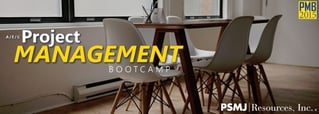Up-and-coming project managers at architecture and engineering firms are often frustrated by how hard it is to “win work.” That’s because, trying to “win work” doesn’t work. If you don’t know where to begin, try these things:
 • Identify a class of problems that you are passionate about. Focus your attention on the types of clients and industries that have this problem, want to solve it, can afford the solution, and you enjoy working with. Don’t overlook internal clients and sub-contractors.
• Identify a class of problems that you are passionate about. Focus your attention on the types of clients and industries that have this problem, want to solve it, can afford the solution, and you enjoy working with. Don’t overlook internal clients and sub-contractors.
• Precisely target your desired clients. Putting your rationale in writing is a great way to test and refine your thinking. It also facilitates sharing for discussion. Then design your tactical plans. If you choose a trade association as a place to meet clients, consider how you would like to be perceived at your first meeting: as a vendor, supporter, or expert. Bring a clear message and image that contacts will pass on to others. Technical credentials and reputation can help initiate or accelerate contacts. Consider technical presentations or service on subcommittees as reputation enhancers. Be careful about aligning yourself with organizations that may be perceived negatively or as activist by your clientele.
• Learn everything you can about your targets. Google alerts, journals, and associations can help you meet the movers and shakers. Get to know them as real people. Learn their businesses inside and out, not just their strengths, weaknesses, threats, and opportunities but the details of how they do what they do on a daily basis. Seek to discover client values and beliefs that you share so you can anticipate their needs before they know they need it.
• Conduct every client encounter as an experiment. Consciously consider how you might carry out several of the possibilities on your list. Test ideas and tactics, but never risk more than you are willing to lose. Use experimentation as a source of originality to spark client interest while being genuine. Never confuse yourself or potential clients about who you are. Engage clients in serious dialog not only for market research, but also to develop a genuine personal relationship.
• Analyze what you are you doing. Set up points in the process to debrief, reflect, and ideally obtain feedback from others. “How is this working?” “What are the results?” “Do your interests align with your firm’s culture?” Tease out elements that work differently from others and try to figure
out why. Build on knowledge gained in earlier iterations. Embrace failure as an acceptable outcome. Failure should not only be acceptable, it may, to some extent, be the preferred outcome—at least for many of your initial possibilities.
Above all, take action. Fail fast, frequently, and affordably to maximize learning. Starting a new process is hard and takes extra time and effort; but in time, rainmaking your way will be far easier, more rewarding, and productive than trying to “win work.”

This article is an excerpt from Guide to Empowering
Project Management, a complimentary ebook.
Interested in beefing up the skills of PMs at your firm with project management training, check out PSMJ's PM Bootcamp.



